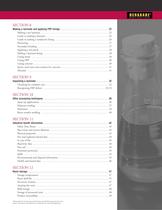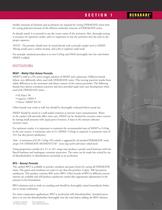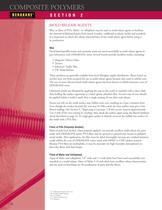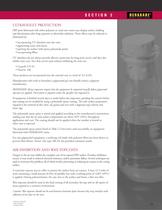 Website:
Ineos composites
Website:
Ineos composites
Group: Ineos
Catalog excerpts

Selecting reinforcements, initiators and cure-control additives . . . . . . . . . . . . . . . . . . . .3 Reinforcement types . . . . . . . . . . . . . . . . . . . . . . . . . . . . . . . . . . . . . . . . . . . . . . . . . . . . . . . . .3Glass storage . . . . . . . . . . . . . . . . . . . . . . . . . . . . . . . . . . . . . . . . . . . . . . . . . . . . . . . . . . . . . . .4Initiators . . . . . . . . . . . . . . . . . . . . . . . . . . . . . . . . . . . . . . . . . . . . . . . . . . . . . . . . . . . . . . . . . .4Non-foaming MEKP substitutes . . . . . . . . . . . . . . . . . . . . . . ....
Open the catalog to page 2
Making a laminate and applying FRP linings . . . . . . . . . . . . . . . . . . . . . . . . . . . . . . . .22 Making a test laminate . . . . . . . . . . . . . . . . . . . . . . . . . . . . . . . . . . . . . . . . . . . . . . . . . . . . . .22Guide to making a laminate . . . . . . . . . . . . . . . . . . . . . . . . . . . . . . . . . . . . . . . . . . . . . . . . . .24Guide to making a conductive lining . . . . . . . . . . . . . . . . . . . . . . . . . . . . . . . . . . . . . . . . . . .26 Postcuring . . . . . . . . . . . . . . . . . . . . . . . . . . . . . . . . . . . . . . . . . . . . . . ....
Open the catalog to page 3
This bulletin is intended to provide practical information that will help fabricators choose themost effective combination of DERAKANEand DERAKANEMOMENTUM > epoxy vinylester resins and reinforcement for many end-use applications.Excellent chemical and corrosion resistance coupled with outstanding heat performance andtoughness have made DERAKANEresins the material of choice for a wide range of fiber reinforced plastic (FRP) applications. All conventional fabricating techniques are used with DERAKANEresins to produce FRP structures having an advantageous combination of strength, toughness and...
Open the catalog to page 4
Nexus > Ү veil (Dacron > 1 homopolymer) > Chopped strand CӔ glass > 1 E. I. DuPont de Nemours & Co.
Open the catalog to page 5
Two mats are generally used with the surfacing veil to form the corrosion liner, providingabout 80 mils of additional corrosion protection. Chopped strand mats also are used in the structural layer between layers of woven roving or as the sole reinforcement for the structural wall.The chopped mat layers in the finished laminate consist of about 70% resin and 30%glass. The short fiber bundles and high resin content help to produce laminates with good strength and excellent chemical resistance.Saint-Gobain Vetrotex > 2 M113 and OC > 2 723A and MPM > 3 mats have given consistently good results...
Open the catalog to page 6
Smaller amounts of initiators and accelerators are required for curing DERAKANEresins thanfor curing polyesters because of the efficient molecular structure of DERAKANEresins. As already stated, it is essential to use the correct ratios of the activators. Also, thorough mixing is necessary for optimum results, and it is important to mix the activators into the resin in the proper sequence. NOTE: The promoter should never be mixed directly with a peroxide catalyst (such as MEKP).Mixing would cause a violent reaction, and a fire or explosion could result. For example, standard procedure is to...
Open the catalog to page 7
Since BPO powders and pastes tend to settle to the bottom of resin solutions, ensure that thestirrer used evenly disperses BPO throughout the resin. For optimum results, the ratio should be from 10 to 20 parts (preferably 10 to 15 parts) active BPO to one part dimethylaniline. Ratios outside that range may cause resin not to gel. The resin may gel and not cure, or a high degree of resin cure may never develop, even with post-curing.Diethylaniline is a less active accelerator than dimethylaniline and can be used when longer geltimes are required. Optimum ratios are from 4 to 12 parts active...
Open the catalog to page 8
Air bubbles in a laminate reduce its strength and may seriously affect its corrosion resistance properties. Air bubbles in the corrosion liner > 1 can be more damaging than those in the structurallayer. The following practices should always be followed to minimize air bubbles:1.Avoid violent mixing which mixes air into resin. However, be sure the catalyst is mixed thoroughly into the resin.2.Apply resin to the mandrels first, then apply glass, and roll it into the resin. Air bubble problems are inevitable when resin is applied to dryӔ glass.3.Roll the laminate from the center to the edges....
Open the catalog to page 12
Wax, or films of PVA, Mylar > 1 , or cellophane may be used as mold release agents to facilitate the removal of fabricated parts from metal, wooden, cardboard or plastic molds and mandrels. It is important to check the release characteristics of any mold release agent before using it in production. > Wax Hard-based paraffin waxes and carnauba waxes are used successfully as mold release agents in part fabrication with DERAKANEresins. Several brands provide excellent results, including:Meguiars > 2 Mirror GlazeՕTrewax > 3 JohnsonՒs > 4 Traffic WaxTR > 5 Mold ReleaseThese products are...
Open the catalog to page 14
FRP parts fabricated with either polyester or vinyl ester resins may display surface chalking and discoloration after long exposure to ultraviolet radiation. These effects may be reduced or eliminated by: incorporating UV absorbers into the resinՕ pigmenting outer resin layers painting the surface with epoxy-polyamide paints Օ incorporating fillersUV absorbers do not always provide effective protection for long-term service and they alsoinhibit resin cure. Two that can be used without inhibiting the resin are: Cyasorb > 6 UV-24Օ Tinuvin > 7 326These products are incorporated into the...
Open the catalog to page 15
DERAKANE411, 411C and 441-400 epoxy vinyl ester resins, when properly formulated andcured, will comply with the U.S. Food, Drug and Cosmetic Act, as amended, and applicable FDA regulations (21 CFR 177.2420). These resins may be used as articles or components of articles intended for repeated use in contact with food, subject to certain limitations described in that regulation. NOTE: It is the responsibility of the customer/user to test the finished laminate or coating to determinecompliance with 21 CFR 177.2420 and all other appropriate regulations. DERAKANE411, 411C and 441-400 epoxy vinyl...
Open the catalog to page 17All Ineos composites catalogs and technical brochures
-
AROTRAN™ 300
2 Pages
-
DERAKANE™ SIGNIA™ RESINS
8 Pages
-
DERAKANE™ SIGNIA™
8 Pages
-
DERAKANE™ FABRICATION GUIDE
76 Pages
Archived catalogs
-
DERAKANE CHEMICAL RESISTANCE GUIDE
84 Pages
-
FR Strategist 2011
4 Pages



















